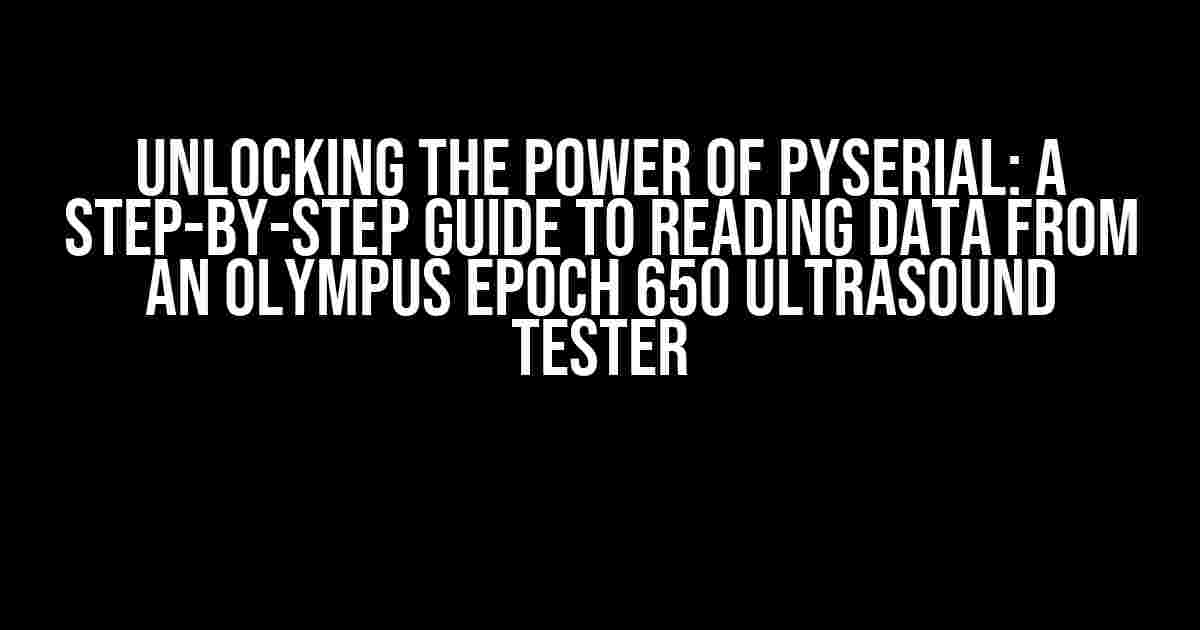Are you tired of manually collecting data from your Olympus Epoch 650 ultrasound tester? Do you wish there was a way to automate the process and make your life easier? Look no further! In this article, we’ll explore the world of pySerial, a powerful Python library that allows you to read data from your Olympus Epoch 650 using a serial connection. By the end of this tutorial, you’ll be able to collect data with ease and unlock the full potential of your ultrasound tester.
What is pySerial?
pySerial is a Python library that provides a simple and intuitive way to communicate with serial devices, such as your Olympus Epoch 650 ultrasound tester. It allows you to read and write data to the device using Python scripts, making it an ideal tool for automating data collection and processing.
Why Use pySerial?
There are several reasons why you should consider using pySerial to read data from your Olympus Epoch 650:
- Automate Data Collection**: pySerial allows you to automate the process of collecting data from your ultrasound tester, saving you time and reducing the risk of human error.
- Efficient Data Processing**: With pySerial, you can process data in real-time, allowing you to analyze and visualize your results immediately.
- Customizable**: pySerial is highly customizable, allowing you to tailor your data collection and processing scripts to your specific needs.
- Cost-Effective**: pySerial is a free and open-source library, making it an attractive option for those on a budget.
Setting Up Your Olympus Epoch 650
Before we dive into the world of pySerial, let’s make sure your Olympus Epoch 650 is set up and ready to go:
- Connect Your Device**: Connect your Olympus Epoch 650 to your computer using a serial cable (usually a USB-to-serial adapter).
- Configure Your Device**: Configure your Olympus Epoch 650 to output data in a format that can be read by pySerial (e.g., CSV or ASCII).
- Install pySerial**: Install the pySerial library on your computer using pip:
pip install pyserial.
Reading Data with pySerial
Now that we have our Olympus Epoch 650 set up and pySerial installed, let’s write a Python script to read data from the device:
import serial
# Open the serial connection
ser = serial.Serial('COM3', 9600, timeout=1) # Replace COM3 with your device's serial port
# Read data from the device
while True:
data = ser.readline().decode('utf-8').strip()
print(data)
# Add a timeout to prevent the script from running indefinitely
if data == "":
break
# Close the serial connection
ser.close()
In this script, we’re using the serial module to open a connection to the Olympus Epoch 650 on serial port COM3 (replace with your device’s serial port). We’re then reading data from the device using the readline() method and printing it to the console. Finally, we’re closing the serial connection to prevent the script from running indefinitely.
Understanding the Data
The data output by the Olympus Epoch 650 will depend on the device’s configuration and the type of test being performed. However, in general, the data will be in a CSV or ASCII format, with each row representing a single data point.
| Column | Description |
|---|---|
| Time | The time at which the data was collected (in seconds) |
| Frequency | The frequency of the ultrasonic signal (in Hz) |
| Amplitude | The amplitude of the ultrasonic signal (in volts) |
| Phase | The phase of the ultrasonic signal (in degrees) |
Processing and Analyzing the Data
Now that we have our data, let’s process and analyze it using Python:
import pandas as pd
import matplotlib.pyplot as plt
# Load the data into a Pandas DataFrame
df = pd.read_csv('data.csv')
# Plot the data using Matplotlib
plt.plot(df['Time'], df['Amplitude'])
plt.xlabel('Time (s)')
plt.ylabel('Amplitude (V)')
plt.title('Ultrasonic Signal Amplitude over Time')
plt.show()
In this example, we’re using the pandas library to load the data into a DataFrame and the matplotlib library to plot the amplitude of the ultrasonic signal over time.
Troubleshooting Common Issues
If you’re experiencing issues with reading data from your Olympus Epoch 650 using pySerial, here are some common solutions:
- Serial Port Issues**: Make sure you’re using the correct serial port and baud rate for your device.
- Data Format Issues**: Ensure that your device is configured to output data in a format that can be read by pySerial (e.g., CSV or ASCII).
- Timeout Issues**: Adjust the timeout value in your script to prevent it from running indefinitely.
Conclusion
With pySerial, reading data from your Olympus Epoch 650 ultrasound tester has never been easier. By following this step-by-step guide, you’ll be able to automate data collection and processing, unlocking the full potential of your device. Whether you’re a researcher, engineer, or simply a curious individual, pySerial is a powerful tool that can help you achieve your goals.
Remember to explore the pySerial documentation and experiment with different scripts to optimize your data collection and processing workflow. Happy coding!
Keyword:** Using pySerial to read data from data logger (Olympus Epoch 650 ultrasound tester)
Frequently Asked Question
Having trouble reading data from your Olympus Epoch 650 ultrasound tester using pySerial? Worry no more! We’ve got you covered with these frequently asked questions and answers.
What is pySerial and how does it help me read data from my Olympus Epoch 650 ultrasound tester?
pySerial is a Python library that allows you to communicate with serial devices, such as your Olympus Epoch 650 ultrasound tester. It enables you to read data from the device and store it in a format that’s easy to work with. With pySerial, you can automate the data collection process and avoid manual data entry, making your workflow more efficient and accurate.
What are the required settings to establish a connection between pySerial and my Olympus Epoch 650 ultrasound tester?
To connect pySerial to your Olympus Epoch 650 ultrasound tester, you’ll need to set the baudrate to 19200, data bits to 8, parity to None, and stop bits to 1. You’ll also need to specify the correct serial port, which can be found in your device’s documentation or through trial and error. Don’t forget to configure your device to output data in a format that pySerial can understand, such as ASCII or CSV.
How do I read data from the Olympus Epoch 650 ultrasound tester using pySerial?
To read data from your Olympus Epoch 650 ultrasound tester using pySerial, you’ll need to open a serial connection to the device, then use the read() or readline() function to capture the data. You can also use the inWaiting() function to check if there’s data available to read. Don’t forget to close the serial connection when you’re done to avoid data corruption or device malfunction.
What are some common issues I might encounter when using pySerial to read data from my Olympus Epoch 650 ultrasound tester?
Some common issues you might encounter when using pySerial to read data from your Olympus Epoch 650 ultrasound tester include incorrect serial settings, faulty cables or connections, and device malfunctions. You might also experience issues with data formatting or parsing, depending on the output format of your device. To troubleshoot these issues, check your device’s documentation, serial settings, and connections, and consider seeking help from online forums or technical support.
Are there any alternative libraries or methods I can use to read data from my Olympus Epoch 650 ultrasound tester?
Yes, there are alternative libraries and methods you can use to read data from your Olympus Epoch 650 ultrasound tester, depending on your specific needs and requirements. Some options include using the device’s built-in software or API, third-party libraries like PyVISA or Python-Olympus, or even manual data entry (although this is not recommended!). Be sure to research and evaluate each option carefully to determine the best fit for your project.


